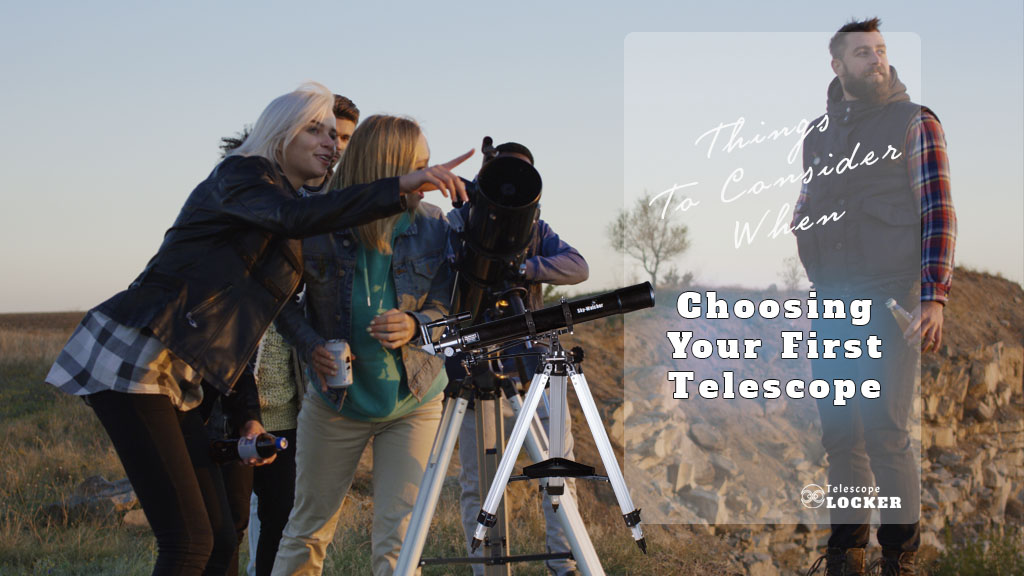Table of Contents
Best Telescopes for Beginners: Discover Your Gateway to the Stars
Starting your stargazing journey can feel overwhelming, but the right telescope can make all the difference. This guide will answer your questions, highlight the best telescopes for beginners and provide tips on what to look for when buying your first telescope.
What Are the Best Telescopes for Beginners?
Here’s a quick summary of the top telescopes for beginners, each carefully selected for their ease of use, performance, and value:
Celestron AstroMaster 102AZ: Great all-around performance.
Celestron StarSense Explorer LT 80AZ: Innovative and user-friendly.
Gskyer Telescope 600x90mm AZ: Affordable and beginner-friendly.
Celestron AstroMaster 70AZ Telescope: Lightweight and versatile.
Celestron PowerSeeker 127EQ: Affordable reflector with strong performance.
Now, let’s dive into the details of each telescope.
Why is The Celestron AstroMaster 102AZ Considered a Good Choice?
Answer: It is easy to use and comes with great optical features and simple control.
The Celestron AstroMaster 102AZ is a good choice for beginners because it is very easy to use and has great optical qualities. With an aperture of 102mm this tabletop refractor telescope offers clear and distinct images of the moon, the planets as well as some of the brighter deep space objects including the Orion Nebula. This telescope is equipped with an Altazimuth mount which can be used in a manual way in order to point and follow the space object of interest.
Pros:
Simple, tool-free setup.
Comes with two eyepieces for high and low power magnification.
Lightweight and very compact construction.
Cons:
Not suitable for deep space observations.
If you are a beginner and in search of a telescope that is easy to use yet very effective, then the AstroMaster 102AZ is ideal for you. Check it out on Amazon Here
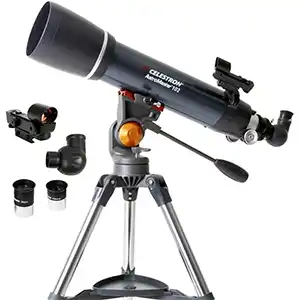
Why Choose the Celestron StarSense Explorer LT 80AZ?
Answer: It is a perfect combination of modern technology and simplicity.
The Celestron StarSense Explorer LT 80AZ takes the normal stargazing to the next level of use through the use of technology. Coupled with your phone and the StarSense app, this telescope will help you identify objects in space with ease. It has an 80mm aperture through which it is capable of delivering clear and distinct images of the sky at night and is ideal for new users.
Pros:
Smartphone Integration: The StarSense application makes the process of searching for certain objects simple and clear.
Lightweight Design: Very lightweight and quite compact in size and quite easy to move around.
Wide Compatibility: It is compatible with most of the smartphones in the market.
Cons:
It is rather limiting to use to its full potential if you don’t have a smartphone.
For those who are just starting out in stargazing, the StarSense Explorer LT 80AZ is a great choice if you want to combine technology with the good old art of stargazing. Check it out on Amazon Here
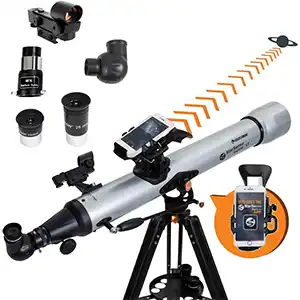
Is the Gskyer Telescope 600x90mm AZ Worth It?
Answer: Yes, it’s a solid choice for beginners and for those who are looking for an affordable telescope.
The Gskyer 600x90mm AZ Telescope is one of the best beginner telescopes which is affordable and yet offers great performance. Through the use of 3x Barlow lens and the two eyepieces that are included the telescope offers a wide range of viewing experiences.
Pros:
Simple to use Altazimuth mount.
Comes with a number of accessories that make it versatile for use.
Affordable price which does not affect the quality of the product.
Cons:
The tripod may be unstable when used at high powers.
This telescope is recommended for the beginners who want to observe the moon, the planets and the bright deep space objects while spending as little as possible. Read our complete review on the Gskyer Telescope 600×90 right here.
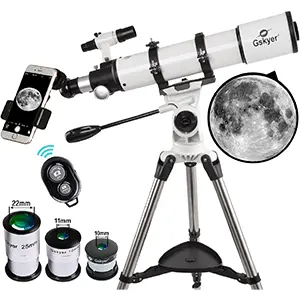
What Makes the Celestron AstroMaster 70AZ Telescope Stand Out?
It is light in weight, quite versatile, and ideal for recreational use in astrophotography.
The Celestron AstroMaster 70AZ Telescope has an aperture of 70mm which makes it suitable for viewing the moon, the planets and some star clusters. Coupled with a lightweight design and an easy to maneuver Altazimuth mount, this is a great telescope for the beginning astronomer.
Pros:
It is light in weight and very compact.
Includes an instructional DVD for hassle-free setup.
Great for both astronomy and daytime use.
Cons:
This telescope has a limited potential for deep space observing.
This telescope is ideal for the beginner who is looking for a smooth and basic introduction to astronomy. Check it out on Amazon here
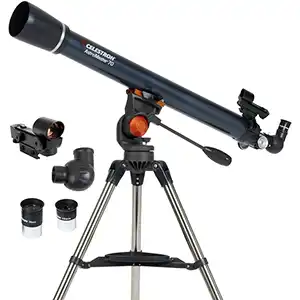
Why Consider the Celestron PowerSeeker 127EQ?
Answer: It is quite affordable yet very effective for the beginners.
The Celestron PowerSeeker 127EQ The Celestron PowerSeeker 127EQ is a reflector telescope which is budget friendly and provides an amazing view of the space. With an aperture of 127mm it is capable of capturing light in abundance, therefore one can be able to differentiate the moon, planets as well as some deep space objects. The equatorial mount makes it possible to follow the movements of celestial objects smoothly.
Pros:
Large aperture which enhances the light gathering ability of the telescope.
Equatorial mount which is used in ordering the rotation of celestial objects to be very accurate.
It also come with multiple eyepieces of different magnification powers that are used in boosting the magnification.
Cons:
The construction of the assembly may be a bit challenging for the beginners.
If you are in the market for a powerful yet cheap telescope, then PowerSeeker 127EQ is a great choice.
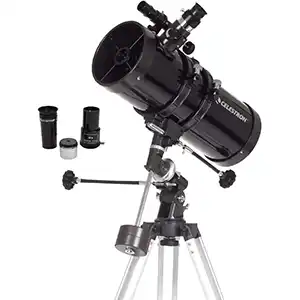
Beginner’s Buying Guide: What to Look for in a Telescope
Key Considerations:
Aperture: The most common way of classifying the quality of a telescope is by the size of its aperture; the bigger the aperture, the more light it is able to capture, and hence produce a clearer image.
Mount Type: The most simple to use type of mount is the altazimuth while the equatorial is ideal for tracking objects.
Portability: When choosing the telescope, consider where you want to use it and if you need a portable and lightweight one.
Accessories: Check for models that come with necessary accessories like eyepieces and finderscopes.
Tips for Beginners:
It is advisable to start with the most basic model and then advance to other models as one gains experience.
It will help if you join local astronomy clubs or online forums to get information and advice from other people.
Don’t forget to check reviews and ratings to make sure you are getting a quality product.
Frequently Asked Questions (FAQs)
Which Telescope Is Best for Beginners?
All the models listed here are excellent choices, but the Celestron AstroMaster 102AZ is a great choice because it is very effective and very easy to use.
Can These Telescopes Be Used for Astrophotography?
Most of the entry level telescopes mentioned here can be used for simple astrophotography if you have a smartphone adapter. To do advanced astrophotography one has to have a specific setup.
How Much Should I Spend on a Beginner Telescope?
Telescope for the beginners can be bought between $100 to $500. Look for a model that is affordable and has features such as large aperture and other accessories.
Final Thoughts: Which Telescope Should You Choose?
So, the right telescope is the first and most important part of the enjoyable night sky observation. All these telescopes have their unique features such as portability, flexibility, or cheap and that is why each of them is worthy of your consideration. Out of the above listed options, any one of them will be more than enough for a beginner to start exploring the universe.
Affiliate Disclosure
This page contains affiliate links. As an Amazon Associate, I earn from qualifying purchases. I also earn commissions from other affiliate programs. These links help support my website at no additional cost to you and allow me to continue creating valuable content for my readers.
For more information about affiliate guidelines, you can visit paidforadvertising.com.
Thank you for your support!


